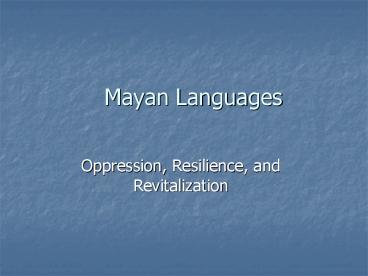Mayan Languages - PowerPoint PPT Presentation
1 / 10
Title:
Mayan Languages
Description:
6 million people in Guatemala. 1 million in central and southern Mexico and Belize ... 20 languages in Guatemala. 9 languages in Yucatan, Mexico. Spanish Conquest ... – PowerPoint PPT presentation
Number of Views:278
Avg rating:3.0/5.0
Title: Mayan Languages
1
Mayan Languages
- Oppression, Resilience, and Revitalization
2
The Mayan People
- Descendants of the ancient Mayan people who lived
in pre-Columbian Meso-America - High level of literary, scientific, artistic
achievement - Used hieroglyphic writing system
- Currently live in Guatemala, Southern and Central
Mexico, and Belize.
3
Mayan Languages
- 6 million people in Guatemala
- 1 million in central and southern Mexico and
Belize - Many monolingual speakers
- 20 languages in Guatemala
- 9 languages in Yucatan, Mexico
4
Spanish Conquest
- Spanish arrival in 1500s exploitation of
indigenous peoples - Extensive Mayan literature destroyed
- Attempts to convert them to Catholicism
- Latin alphabet adopted by intellectual Mayan
scribes, old texts adapted - 4 surviving texts
5
ResilienceThe Mayans preserve their language
after half a millennium of successful resistance
to Spanish encroachment
- Spanish dominance over land ownership
- Mayans continue to speak their native languages
and practice their culture. - Extremely large numbers of monolingual speakers
up until 1970 - Guatemalan Civil War- suffered violence and
ethnocide
6
Language Shift
- Bilingualism- response to socio-economic and
political forces - Shifts occur by way of parents speaking the
second language to offspring (note parents must
be bilingual before this can occur.) - Benefits of learning Spanish
- Widespread recognition of increased economic
opportunity through Spanish acquisition - Better ability to preserve indigenous language by
understanding those who oppress it.
7
Language Shift (cont.)
- Domestic influence
- - Preparation for schooling
- - Naïveté regarding language acquisition
- - Unintentional negative effects
- Studies show the ages of the mother affects the
proficiency in indigenous language
8
Why worry?
- Mayan languages are the primary means through
which Maya philosophy and world view are
transmitted as well as being an important part of
identity. - Many meanings cannot be represented in Spanish
- Of course we must deal with language first, and
then with other matters.
9
Language Standardization
- Language not used for as many purposes as they
used to be - writing not as common
- Historically little agreement on standards for
writing, presently an important issue in the
revitalization movement - No concept of prestige language, no consensus on
which language would be mostly used in
standardization - Academy of Mayan Language est. 1991
- Convened 4 yrs before academy was approved to
create a unified alphabet - Non Maya not part of decision making process,
linguistic self determination - Rejected many Spanish orthographic principles-
asserted that the importance of writing Mayan
languages was solely for the value of literacy in
Maya as language in itself
10
Bilingual Education
- PRONEBI (National Program for the Promotion of
Bilingual Education) - Soon after est., state intimidation through
violent intervention - Largely dependent on the standardization of the
language - Not affiliated with the Academy in that they
print materials for schools without official
approval - Note Many of these teachers are merely orally
proficient rather than literate so these
materials may not be able to be utilized - Many believe their policies are assimilationist
- Materials are not uniform because of the
differences within the Maya languages - The actual instruction in Mayan is typically
minimal but bilingual education is on the rise































